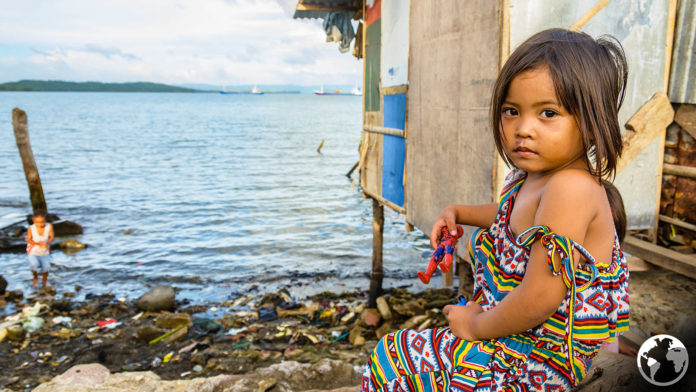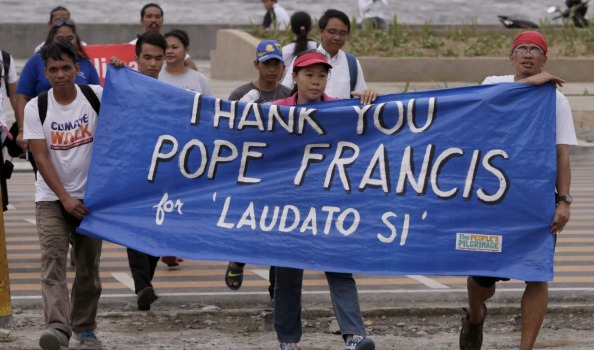
In the coming days, the Philippines, is likely to face not only more catastrophic typhoons but also heat waves, coastal flooding, loss of fisheries and forests, drought, and widespread food shortages. The country was ranked the third-most vulnerable to climate change-related effects in the world by the United Nations, and a 2013 government report warned that other events besides natural disasters, such as torrential rainfall or rising sea levels, could also prove hazardous to the country.
With rising sea levels multiplying the impact of tropical storms and hurricanes, and climate change influencing the effects of extreme weather events like typhoons, Filipino Christians are responding to Pope Francis’ call for action with moves to slash agricultural greenhouse gas emissions.
Inspired in part by Pope Francis’s June 2015 encyclical on the environment that said the world must act on climate change and that a failure to do so presents an undeniable risk to a “common home” that is beginning to resemble a “pile of filth”, the government has promised to cut 70% of the country’s greenhouse gas emissions by 2030—even though the total Philippine contribution to global emissions is less than 1%—in exchange for financial assistance.
Rice Power
Rice is the Philippines’ most important food crop, but as typhoons regularly wipe out rice crops and rising temperatures lowers agricultural productivity, production has not been able to keep up with population growth. So the country has decided to make some necessary improvements to rice cultivation methods in order to reduce greenhouse gas emission and help mitigate climate change.
Fueled entirely by rice husks, a 12-megawatt power plant is set up in San Jose City in the province of Nueva Ecija. Burning 12 to 14 metric tons per hour of husk, the plant generates enough electricity to power tens of thousands of homes. In other words, the government, private enterprise, scientists, rice farmers and the millers worked togther to mitigate greenhouse gas emissions in agriculture, and concurrently produced cleaner electricity.
“It’s a prime example of how adaptation and mitigation are “co-benefits” in the fight against climate change. It’s really a collective effort, otherwise there’s no impact,” Evangeline “Vangie” Sibayan, an agricultural engineer and head research specialist at the Philippine Rice Research Institute, told Take Part.
Teams of scientists are developing more resilient, more productive varieties of rice that can better cope with the changing climate. They’re also plotting ways to make radical improvements in cultivation methods—to save water, improve yields, reduce methane gas emissions, and curtail the use of fossil fuels.
In the news: Educated and younger #farmers energize #Philippines #rice #farming http://t.co/hn5M5wegSb
— Rice Today (@ricetoday) April 27, 2015
Alexandra Soezer, MDG Carbon Project Manager, UNDP, writes:
“Our Adaptation and Mitigation program is aimed to improve local cultivation techniques in order to lower greenhouse gas emission. Irrigation techniques like the applied Alternative Wetting and Drying, allow for modification of water management for shorter periods of rice flooding and a reduction of methane emissions. The first phase of the program involves building capacity for these improved techniques and supporting farmers in diversifying their income sources through the production of mushrooms, vegetables or other crops. It was estimated that this would help the Philippines reduce greenhouse gas emission by 36,455,063 tons of carbon dioxide. The program would eventually be extended to the entire country and double the emission reduction potential.”
Power of Faith
Father Edwin Gariguez, executive director of the national secretariat for social action [the Philippine Catholic church’s nationwide social action group], told The Guardian:
“We believe that by using existing sustainable farming techniques, we can increase progressively soil organic matter by 60 tons per hectare over the next 50 years. In the process we would have captured more than two-thirds of the current excess of CO2 in the atmosphere.”
Mayette Rodriguez, executive director of Aksyon Klima, a coalition of 40 organizations working on climate change in the Philippines, credits the church’s call to action for raising general awareness among Filipinos. She told Take Part that in her neighborhood in Manila there has seen an increase in environmentally friendly activities such as recycling.
“It’s important for the grassroots to realize that the power actually lies in their hands. They have been disempowered for so long that they have to be reminded that if they are consolidated they can effect change in society.”
David Page of Take Part reports:
“Tanauan was the first Haiyan-devastated municipality to come up with a plan to prepare and adapt to future climate change–spawned super typhoons, less than two months after the disaster [in 2013]. Funding has been sporadic, and implementation on nearly every front has been excruciatingly slow; however, there have been successes. Streetlights have been restored and converted to energy-efficient LED. Schools have been rebuilt with second stories that can serve as evacuation centers. Fishing boats and pedicabs have been replaced. Rice farmers were given free high-yield seeds and fertilizers and in 2014 brought in record harvests. The number of completed resettlement housing units is about to reach 400, providing stormproof shelter, more than a mile inland, for nearly half of the estimated 880 families living in what the mayor calls “danger areas” along the shoreline. The average resettlement rate elsewhere is less than 10%.”
When he asked Pel Tecson, the mayor of Tanauan, to what extent the pope’s campaign for climate action has helped the process, Tecson replied, “Of course, the church is integral, not merely in helping to restore the victims’ faith, but also in charting a way forward. It’s great that there’s advocacy from all sectors because we need everybody.”
Catholics In Philippines Make Climate Change A Priority After Pope Francis … – International Business Times http://t.co/H7I09GPmId
— Climate Change agent (@climatechange_a) July 22, 2015
Father Al Cris Badana of the Relief and Rehabilitation Unit of the Archdiocese of Palo, who along with his brothers helped rebuild more than 500 homes since Haiyan, holds a series of meetings with the community, to let residents determine and articulate their own needs.
“First we have to listen to what they really want. Many rice farmers, he says, would prefer a water buffalo to a mechanical harvester. The latter requires gasoline, ongoing maintenance, and technical training, while the former can sustain itself simply by eating grass. The animal also provides milk and reproduces. For about $700, the church can provide a water buffalo that serves five families, with a written agreement that the offspring is given to the next in line.”
Badana concluded, “If Mao Zedong has his ‘Red Book’, we have our own red book: the ‘Laudato Si’ [Pope Francis’ encyclical]. This is our guide in our interventions.”
This Article (Religion Acts As Catalyst: How Christians Are Fighting Typhoons, Climate Change In The Philippines) is free and open source. You have permission to republish this article under a Creative Commons license with attribution to the author and AnonHQ.com.








I feel that most religions aren’t much different from one another. It would make more sense the different practices and deities are really just different interpretations of the same thing as opposed to entirely new, unrelated Gods. Instead of fighting because of the differences between us, we should stand together because of what’s the same.